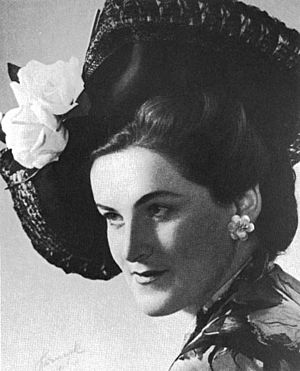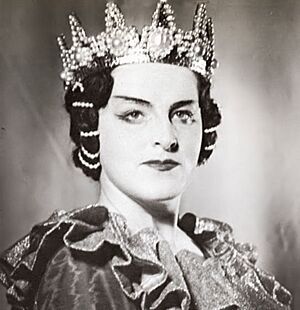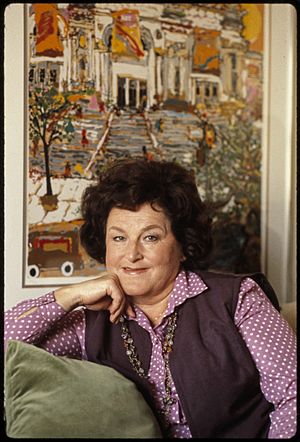Birgit Nilsson facts for kids
Quick facts for kids
Birgit Nilsson
|
|
|---|---|

Birgit Nilsson in 1948
|
|
| Born |
Märta Birgit Svensson
17 May 1918 |
| Died | 25 December 2005 (aged 87) |
| Education | Royal Swedish Academy of Music |
| Occupation | Wagnerian soprano |
| Years active | 1946–1984 |
| Awards |
|
Märta Birgit Nilsson (born May 17, 1918 – died December 25, 2005) was a very famous Swedish opera singer. She was a dramatic soprano, which means she had a powerful and strong voice. Birgit Nilsson was best known for singing in the operas of Richard Wagner and Richard Strauss. Her voice was known for its amazing power and clear, bright high notes.
Contents
About Birgit Nilsson
Her Early Life
Birgit Nilsson was born Märta Birgit Svensson on a farm in Västra Karup, Skåne, Sweden. When she was just three years old, she started playing melodies on a toy piano. She once said she could sing even before she could walk! Her singing talent was first noticed when she joined her church choir. A choirmaster heard her and told her to take singing lessons.
She studied for six months to prepare for an audition at the Royal Swedish Academy of Music in Stockholm. She was the best out of 47 singers and won a special scholarship. Even with teachers, she felt she taught herself the most. She believed the best way to learn was by performing on stage.
Starting Her Career
In 1946, Birgit Nilsson made her first big performance at the Royal Swedish Opera in Stockholm. She had only three days to prepare! She quickly became famous in Sweden in 1947 for her role as Lady Macbeth in Giuseppe Verdi's opera Macbeth. After that, she sang many different roles in operas by famous composers like Richard Strauss, Giuseppe Verdi, Richard Wagner, and Giacomo Puccini. She sang many of these roles in Swedish.
Becoming Famous Worldwide

Her career really took off after she performed as Electra in Mozart's Idomeneo in England in 1951. Her first performance at the Vienna State Opera in 1953 was a big moment. She performed there regularly for over 25 years! She also sang at the famous Bayreuth Festival in Germany in 1954.
Nilsson sang the main role of Turandot in La Scala in Milan, Italy, in 1958. This role needs a very big voice. She made her American debut in 1956 in San Francisco. She became an international star after singing Isolde at the Metropolitan Opera in New York City in 1959. This performance was so important it made front-page news! She performed in many major opera houses around the world.
Her Voice and Roles
Birgit Nilsson was known as the best Wagnerian soprano of her time. She was especially famous for her role as Brünnhilde. But she also sang many other important soprano roles. These included Leonore, Aida, Turandot, Tosca, Elektra, and Salome. The New York Times said she had a "voice of impeccable trueness and impregnable stamina." This means her voice was always perfect and never got tired.
She believed her long career was due to being born with "the right set of parents." She didn't smoke and only drank a little wine and beer. Her powerful high notes were her biggest strength on stage. However, she felt that recordings never truly captured how amazing her voice sounded live.
Nilsson sometimes had accidents on stage. In 1971, she sprained her ankle during a performance. In 1974, she dislocated her shoulder during a rehearsal. Even with her arm in a sling, she still managed to sing some performances!
Birgit Nilsson's Humor
Birgit Nilsson was also known for her great sense of humor. She often joked with famous conductors. Once, when her pearl necklace broke during rehearsal, a conductor asked if the pearls were real. She quickly replied, "No, these are fake pearls bought with your Vienna State Opera fees!"
She also had a fun rivalry with tenor Franco Corelli. They would try to hold a high note longer than each other in the opera Turandot. One time, after she held the note longer, Corelli was upset. The opera director, Rudolf Bing, joked that Corelli should bite Nilsson on the neck during their kiss scene in the opera. Nilsson found this so funny that she later told Bing she had to cancel performances because she had "contracted rabies"!
Another time, when Nilsson started singing Aida at the Met, another soprano, Zinka Milanov, was annoyed because Aida used to be her role. After a performance, Milanov took Nilsson's hired Rolls-Royce car. When asked about it, Milanov said, "If Madame Nilsson takes my roles, I must take her Rolls."
When asked the secret to singing the difficult role of Isolde, Nilsson famously said, "comfortable shoes." She also joked that Isolde made her famous, but Turandot made her rich!
Her Business Savvy
Nilsson was also very smart about money. She became one of the highest-paid singers because her skills were so rare. She often handled her own contracts. She was calm and never threw tantrums. She would start contract talks by saying no to every offer. This would continue until the opera house offered what she really wanted. Then she would say "maybe," and they would beg her to accept.

Standing Up to Conductors
Nilsson was known for not being afraid to stand up to conductors. During a rehearsal where the stage lighting was too dark, she wore a miner's helmet with Valkyrian wings to make a point! When a conductor told her to sing with "more heart," she replied, "I'm so pleased to find we have something in common."
Recordings
Birgit Nilsson recorded all of her major opera roles. She also made many recordings of songs and concerts. Because she was so good at playing Brünnhilde, a record company decided to record Wagner's entire Ring Cycle. This huge project took seven years, from 1958 to 1965.
Later Life and Legacy
Nilsson wrote her autobiography, Mina minnesbilder (My memoirs in pictures), in 1977. She retired in 1984 and moved back to her childhood home in southern Sweden. Her family had been farmers there for generations. She once said, "Stay close to the earth. Then when you fall down, it won't hurt so much."
In 1981, Sweden honored her with a postage stamp showing her as Turandot. She also received the Illis quorum gold medal, which is a very high award in Sweden. In 1988, a special prize for young American opera singers was named the Birgit Nilsson Prize in her honor.
Birgit Nilsson passed away on December 25, 2005, at the age of 87. She was survived by her husband, Bertil Niklasson, whom she married in 1948. They did not have any children.
Three years after her death, the Birgit Nilsson Foundation announced a major prize. This prize is given every few years to a great singer, conductor, or opera production. Birgit Nilsson herself helped set up the funding for this award. The first winner was the famous tenor Plácido Domingo in 2009, who received $1,000,000.
A train in Sweden has been named "Birgit Nilsson" in her honor. Also, in 2011, the Bank of Sweden announced that her picture would be on the 500 kronor banknote starting in 2016.
Awards and Honors
- 1954 Royal Court Singer (Sweden)
- 1958 Gold Medal, Teatro Liceo, Barcelona, Spain
- 1960

 Royal medal Litteris et Artibus
Royal medal Litteris et Artibus - 1960 Honorary member of the Royal Swedish Academy of Music, Stockholm
- 1966 Sonning Award, Denmark
- 1967 Gold Medal For the Promotion of the Art of Music (Sweden)
- 1968 Austrian Kammersängerin
- 1968 Honorary Member of the Vienna State Opera, Vienna, Austria
- 1970 Honorary doctorate from Merrimack College, USA
- 1970 Honorary Member of the Royal Academy of Music, London, England
- 1970 Bavarian Kammersängerin, Munich, Germany
- 1972

 Royal medal Ingenio et Arti
Royal medal Ingenio et Arti - 1974

 Commander First Class of the Order of Vasa
Commander First Class of the Order of Vasa - 1975

 Commander First Class of the Order of St. Olav
Commander First Class of the Order of St. Olav - 1981 Gold medal of the Royal Opera Stockholm
- 1981

 Illis Quorum gold medal
Illis Quorum gold medal - 1982 Honorary doctorate from the Manhattan School of Music, New York City
- 1982 Honorary doctorate from Michigan State University, USA
- 1982 Swedish-American of the Year Award, New York City
- 1988

 Cross of Merit First Class of the Lower Saxony Order of Merit
Cross of Merit First Class of the Lower Saxony Order of Merit - 1991

 Commandeur des Arts et des Lettres
Commandeur des Arts et des Lettres - 1993 Royal Opera House Silver Medal for 25-year's service as a Guest Artist, London, England
- 1994 Award of the Sweden–America Foundation, New York City
- 1997 Honorary doctorate of the Sibelius Academy, Helsinki, Finland
- 1999 Honorary member of the Vienna Philharmonic Orchestra, Vienna, Austria
- 2012 Gramophone's Hall of Fame in 2012
Videography
- The Metropolitan Opera Centennial Gala, Deutsche Grammophon DVD, 00440-073-4538
See also
 In Spanish: Birgit Nilsson para niños
In Spanish: Birgit Nilsson para niños


